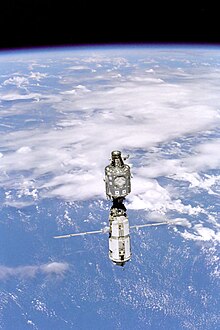STS-88
| Mission emblem | |||
|---|---|---|---|

|
|||
| Mission dates | |||
| Mission: | STS-88 | ||
| COSPAR-ID : | 1998-069A | ||
| Crew: | 6th | ||
| Begin: | December 4, 1998, 08:35:34 UTC | ||
| Starting place: | Kennedy Space Center , LC-39A | ||
| Space station: | ISS | ||
| Coupling: | December 7, 1998, 02:07:00 UTC | ||
| Decoupling: | December 13, 1998, 20:24:30 UTC | ||
| Duration on the ISS: | 6d 18h 17m 30s | ||
| Landing: | December 16, 1998, 03:53:33 UTC | ||
| Landing place: | Kennedy Space Center, Lane 15 | ||
| Flight duration: | 11d 19h 17m 59s | ||
| Earth orbits: | 185 | ||
| Track height: | 320 km | ||
| Covered track: | 7.6 million km | ||
| Payload: | Connection module Unity , PMA-1 and PMA-2 | ||
| Team photo | |||
 v. l. No. Sergei Krikaljow, Jerry Ross, Robert Cabana, Frederick Sturckow, James Newman, Nancy Currie |
|||
| ◄ Before / After ► | |||
|
|||
STS-88 ( english S pace T ransportation S ystem) is the mission designation for a flight of the US Space Shuttle Endeavor ( OV -105) of NASA . The launch took place on December 4, 1998. It was the 93rd space shuttle mission, the 13th flight of the space shuttle Endeavor and the first flight of a shuttle to the International Space Station (ISS).
team
- Robert Cabana (4th space flight), commander
- Frederick Sturckow (1st space flight), pilot
- Nancy Currie (3rd space flight), Mission Specialist
-
Sergei Krikaljow (4th space flight), mission specialist ( Roskosmos / Russia )

- James Newman (3rd space flight), mission specialist
- Jerry Ross (6th spaceflight), mission specialist
Mission description
The International Space Station (ISS) was practically inaugurated during the Endeavor mission . In the loading bay of the space shuttle, Unity was the first connection module of the space station along with two coupling adapters (PMA-1 and PMA-2).
Shortly after the launch on December 4, 1998 at 8:35 UTC, the three interconnected parts were lifted out of the cargo bay with the manipulator arm and placed on the coupling adapter of the space shuttle. This approached during which the started already on November 20 module Zarya . On December 6th, it was caught by the shuttle arm of the space shuttle from a distance of about ten meters and placed on the second coupling adapter from Unity.
On December 7th, astronauts Jerry Ross and James Newman stepped out for 7 hours and 21 minutes and connected the power and data cables between the two modules. Thermal covers and a retaining cable were also installed. During the second exit on December 9, the now superfluous brackets with which Unity was anchored in the Endeavor's loading bay were removed in seven hours. There, the counter brackets were covered and cables that had previously been used for power supply and cooling were dismantled. In addition, several communication antennas were attached and connected. Finally, an antenna on the Sarja module, which is part of an automatic rendezvous system, was completely unfolded. Then the power supply between Zarya and Unity was activated. A pressure compensation had already been carried out beforehand.
On December 10, the hatches were opened and the station was manned, if only for a short time. Within the two modules, transport brackets were removed, tools and superstructures that were to be attached outboard were removed and the shelves were filled with materials intended for the first permanent crew. In addition, the S-band communication system was completed and tested. The hatches were closed again after only 28 hours.
When Ross and Newman disembarked for the third time on December 12, containers with tools, hand and foot racks and two cranes were attached outboard and a railing was installed on the Zarya module within 6 hours and 59 minutes. The second antenna of the Russian course navigation system could also be fully extended manually. In addition, the outer skin of both modules was photographed from different positions. In doing so, particular attention was paid to whether the markings for the Space Vision System were clearly visible. All activities were also filmed by a large format IMAX camera.
On board the Endeavor there were two small satellites, MightySat 1 and SAC-A, which were catapulted from the cargo bay during the mission. The latter was released on December 14th at 5:31 UTC and was an Argentine satellite (268 kilograms) for testing various technologies. These included a GPS- based navigation system , a magnetometer , silicon solar cells, a camera for observing the earth and a system for tracking whales in the world's oceans. MightySat, a military test satellite of the US Air Force, followed at 3:09 UTC the next day . The 320-kilogram Trabant was also used to research new technologies for space travel.
After almost twelve days in orbit, the Endeavor landed on December 16 at 3:53 UTC on the concrete runway of the Kennedy Space Center in Florida.
See also
Web links
- NASA Mission overview (English)
- Video summary with comments of the crew (English)
- NASA website of the Mission (English)
- NASA video of Mission (English)



